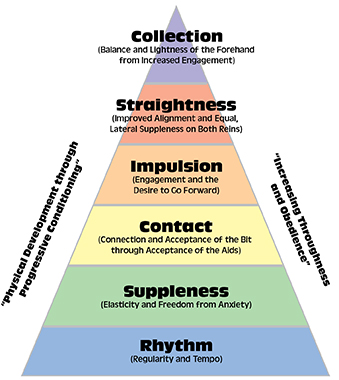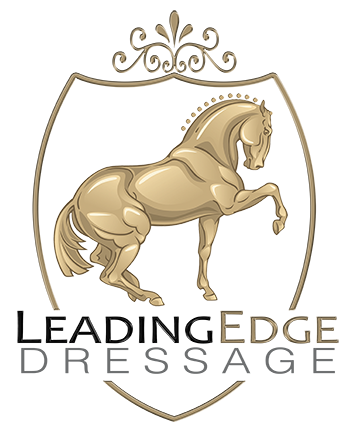Understanding your score
Whether you are riding intro A or second level test 2 how you approach the test as a whole, can make a significant difference in your score. It is not uncommon for riders to focus on riding the correct pattern of the dressage test. I see it often; they drill it over and over until both the rider and horse know it by heart. They are ready, and head to a show. Both horse and rider know exactly where they are going and successfully hit every letter. Coming out of the arena they are confidence that they have done well. When the results are posted they can’t believe that their score is so lackluster. I know it can be very discouraging.
What does your judge see that you are missing?
This all goes back to the training pyramid. Each move is judged exactly as this pyramid shows. EACH MOVE. So, the circle at A, or the short diagonal, or the halt-salute, they will go through their version of this scale of skills to decide on the score. You can use this scale to know exactly where you are on your journey to great riding.

The bottom of this pyramid is Rhythm, and that is the first thing your judge is looking for. When you enter at A, and halt at X, did your horse come in with a clear steady rhythm? Or was he wiggly, wobbly, distracted, and not showing his best self? The steady metronome type trot will get the best beginning score. It will go up and down from there depending on how well each of the other levels on the pyramid are shown. These are, of course, with the expectations of the skill level required in the particular test you are riding.
Relaxation is the next step. And this one is a challenge for most. Not many horses go to a show and are as relaxed as at home. So much to look at with the busy atmosphere of a show. Cars, trailers coming and going, horses everywhere, it can be total chaos. I once had a deer wander into the arena while I was showing. Let’s just say my horse was not relaxed at that moment, or for several movements after! What you can expect, is that the unexpected will happen. Preparation is key! If your horse can not stay relaxed and focused you need to work on that, not the pattern of the test. Go places, do groundwork, desensitize, build trust, it will make a big difference. Imagine going down the centerline with a partner that can stay focused! The best feeling.
When your horse is rhythmic and relaxed, the next piece becomes much easier to achieve. Connection, or acceptance of the bit and aids. Once labeled contact, this word was changed not too long ago. I like this label as it has a more “reaching for positive” instead of “doing this wrong” feel to it. And it is not all about the bit. Your horse not being connected is an obedience issue, but not one that requires discipline or exercise drilling, which will actually make the rest of the training pyramid impossible to achieve if not done correctly. And connection is more than just the rein contact. I love watching a horse and rider that are connected. They move as one, and it is an unmistakable thing to see. Beautiful, harmonious, and graceful, that is connection.
As you move up the levels, impulsion plays a bigger role. Thrust is the big word at first level. Is that horse pushing from behind? Can they take bigger steps? Or do they get quick and mincy in the lengthen? If your horse is Rhythmic, and Relaxed/Supple, and you have a good connection, then impulsion becomes possible. The tempo needs to stay the same in a lengthen as in a working trot or canter. Bigger, more powerful strides are important to the next piece of the pyramid.
Straightness is next and it might seem like a simple thing, but very often is a .5 deduction in several movements. A few things to consider:
1) your horse’s nose is 4” wide, his butt may be 4’ wide. If you ride his nose on the rail, he will be crooked. That is just physics.
2) Another piece that is pure physics is the inside rein riding. Pulling on an inside rein causes your horse to curl his hip to the inside. Yes, your horse needs to have inside bend, and as I said above, you don’t want to keep his nose on the rail. It needs to come from your inside leg and outside rein instead.
Ultimately if all the other pieces of the pyramid are working well you can also begin to achieve the all-important Collection. This does not mean pull on the reins and slow your horse down. It means your horse effectively brings the hind end under and carries more weight there. It means you have more lift of the front end. And it is only starting to be looked at in second level for a reason. Because of the time it takes to build the strength to be successful at this. All the while keeping in mind the rest of the pyramid as well.
So, you enter at A, are trotting down the centerline to X, your horse is rhythmic, relaxed and is actually listening to you. You halt at X and it feels balanced. Your horse stands quietly waiting for your aid to move off. When you ask for the forward following a lovely salute, your horse immediately steps into his lovely rhythmic trot and tracks straight to C before making the turn into the next movement.
Your score for that move? I am guessing will be fairly good but will still be dependent on a few more things. That is, the quality of the gaits. Which sometimes just a god given talent, and sometimes completely connected to Rhythm, Relaxation, Connection, Impulsion, Straightness and Collection. I will say it again, EACH move needs all these things. Because the quality or your horse’s gaits depends on them.
Think about a pyramid, this shape was used as a symbol for a reason. The base is broad and strong, if it is built well, it will support the rest of the structure, if it has holes, it will eventually crumble. Spending more time on the base, ensuring it is solid will bring much more success to those who make this commitment. It takes time to develop the foundation. But you will reap great rewards if you do. Hopefully this gives you something to think about. It’s a wonderful journey, enjoy the ride.

